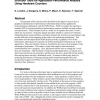Free Online Productivity Tools
i2Speak
i2Symbol
i2OCR
iTex2Img
iWeb2Print
iWeb2Shot
i2Type
iPdf2Split
iPdf2Merge
i2Bopomofo
i2Arabic
i2Style
i2Image
i2PDF
iLatex2Rtf
Sci2ools
ISCAPDCS
2001
2001
End-user Tools for Application Performance Analysis Using Hardware Counters
One purpose of the end-user tools described in this paper is to give users a graphical representation of performance information that has been gathered by instrumenting an application with the PAPI library. PAPI is a project that specifies a standard API for accessing hardware performance counters available on most modern microprocessors. These counters exist as a small set of registers that count "events", which are occurrences of specific signals and states related to a processor's function. Monitoring these events facilitates correlation between the structure of source/object code and the efficiency of the mapping of that code to the underlying architecture. The perfometer tool developed by the PAPI project provides a graphical view of this information, allowing users to quickly see where performance bottlenecks are in their application. Only one function call has to be added by the user to their program to take advantage of perfometer. This makes it quick and simple...
Hardware Performance Counters | ISCAPDCS 2001 | ISCAPDCS 2007 | PAPI Library | Perfometer Allows Users |
| Added | 31 Oct 2010 |
| Updated | 31 Oct 2010 |
| Type | Conference |
| Year | 2001 |
| Where | ISCAPDCS |
| Authors | Kevin S. London, Jack Dongarra, Shirley Moore, Philip Mucci, Keith Seymour, T. Spencer |
Comments (0)

